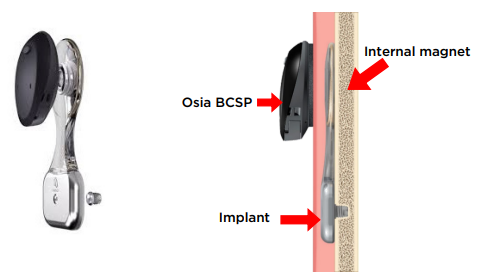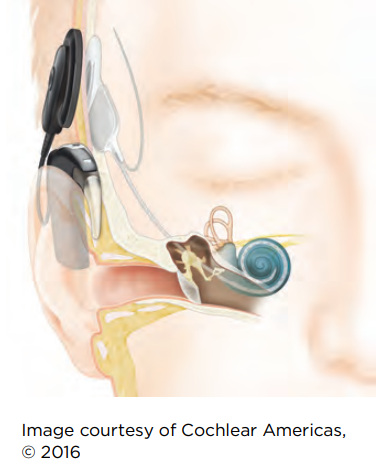Hearing Devices and Amplification
What are my child’s options for hearing devices?
Your child’s audiologist will talk with you about the best hearing device options based on your child’s age, anatomy, degree of hearing loss and listening needs. Sometimes these devices are called “amplification.” The audiologist may also talk with your child’s otolaryngologist about their recommendation for a hearing device. Most devices require medical clearance from an otolaryngologist prior to fitting. Your audiologist will go through the options with you.
Types of hearing loss
Hearing loss can be in one ear (unilateral) or in both ears (bilateral). The three most common types of hearing loss are (see illustration of ear):
• Conductive hearing loss is hearing loss in the outer ear, middle ear or both.
• Sensorineural hearing loss refers to hearing loss in the inner ear, or hearing (auditory) nerve or both.
• Mixed hearing loss refers to a combination of conductive and sensorineural hearing loss.
Does my insurance cover hearing devices? (For those in the USA)
• Insurance coverage for hearing devices varies. Call your insurance to check for benefits.
• Coverage may be different depending on the type of hearing device(s).
• Your audiologist can give you information about other financial resources for getting hearing devices. Click here for hearing aid insurance laws by state.
Types of hearing devices
Ear-level hearing aids
Behind the ear (BTE)
This is a traditional hearing aid that goes behind the ear (BTE). The style used will depend on your child’s age, listening needs and size of their ear canal. This style is chosen for children who have a pinna and an ear canal.
In the ear (ITE)
This hearing aid goes in the ear (ITE). This style may be considered for older children who have an ear canal and whose ears are no longer growing.
CROS and BiCROS hearing systems
This is a traditional hearing aid that goes behind the ear (BTE). The style used will depend on your child’s age, listening needs and size of their ear canal. This style is chosen for children who have a pinna and an ear canal.
BiCROS stands for “Bilateral Contralateral Routing of Signal.” This system includes a microphone worn on the poorer hearing ear and a behind-the- ear hearing aid worn on the better hearing ear. The hearing aid provides amplification and receives the signal from the poorer hearing ear.
Bone conduction hearing devices
Bone conduction hearing devices transfer sound waves through the bones in the skull (called bone conduction) to the inner ear. The sound is sent through a device called a bone oscillator. These devices are designed for people with certain types of hearing loss who cannot benefit from a behind-the-ear hearing aid. Your child may benefit from this device if they have:
• Conductive or mixed hearing loss that is present from birth
• Chronic middle ear disease
• Chronic external ear canal infections
• Deafness in one ear
Bone conduction sound processor (BCSP)
This device includes a microphone, digital processor and bone oscillator in the same casing. The BCSP can be mounted non-surgically (band retained) or surgically (implant retained).
Band-Retained BCSP
The sound processor is retained on either a softband or a hard headband.
Osseointegrated implant retained BCSP (OIBSP)
Bone conduction sound processors (BCSPs) can be used with an osseointegrated implant that is placed surgically in the skull behind the ear. The ossoeintegrated implant is part of the BCSP hearing system. The BCSP attaches to the outside of the head either to an abutment that comes through the scalp or to a magnet that is under the scalp. The audiologist will talk with your child’s otolaryngologist to see if this is an option.
Osia
The Osia is a different type of OIBCSP system. It has different features than the abutment and magnet retained implants. The Osia implant uses digital stimulation with mechanical pressure to create an electrical charge. In this system a transducer and magnet are attached to the osseointegrated implant and placed under the scalp in a single surgery. A child will need to wait for 1 to 2 months before being fit with the external Osia sound processor.
FM/DM system
FM/DM stands for “Frequency Modulated/DigitallyModulated System.”
The purpose of an FM/DM system is to improve the signal to noise ratio. These systems do not amplify the sound.
This system can be used alone or with other hearing devices. If it connects to a hearing device, then the hearing device will amplify the sound. The system includes a microphone, transmitter and receiver. The talker (such as your child’s teacher) wears a small microphone that delivers sounds directly to your child. Your child wears a receiver that picks up sound from the talker.
Cochlear Implant
Cochlear implants are small, surgically implanted electronic devices that can help provide deaf or hard-of -hearing children with a sense of sound. They work by directly stimulating the hearing nerves with electrical signals. A cochlear implant consists of two parts. The first part goes inside the skull and is called the internal receiver or stimulator. This part is placed during surgery. The second part is a speech processor worn on the outside of the head.
In order to be considered for a cochlear implant, your child must:
Have a bilateral severe to profound sensorineural hearing loss
Be at least 12 months old at the time of surgery
Have completed a trial using a hearing aid
Children from 2 to 18 years old must show a lack of hearing progress with well-fit hearing aids.
Children with progressive hearing loss must show that they are not getting adequate benefit from well-fit hearing aids.
A surgeon, speech-language pathologist, psychologist, and audiologist will evaluate your child to see if a cochlear implant is an option for them.
How a cochlear implant works:
The external sound processor is worn behind the ear. It captures sound, then filters and processes the sound, turning it into digital code.
The sound processor transmits the digitally-coded sound through the coil on the outside of the head to the implant.
The internal implant converts the digitally-coded sound into electrical impulses and sends them along the electrode array that sits gently in the cochlea (the inner ear).
The implant’s electrodes stimulate the cochlea’s hearing nerve, bypassing the damaged cells that cause hearing loss, sending impulses to the brain where they are interpreted as sound.
This information was provided by the Seattle Children’s Audiology Care Team. More information about hearing loss can be found here.









